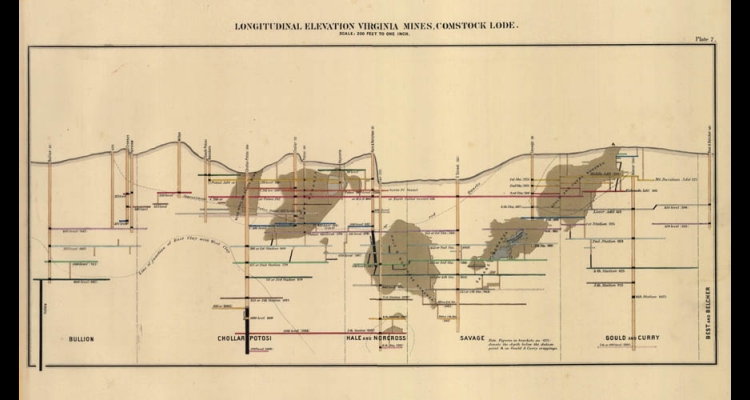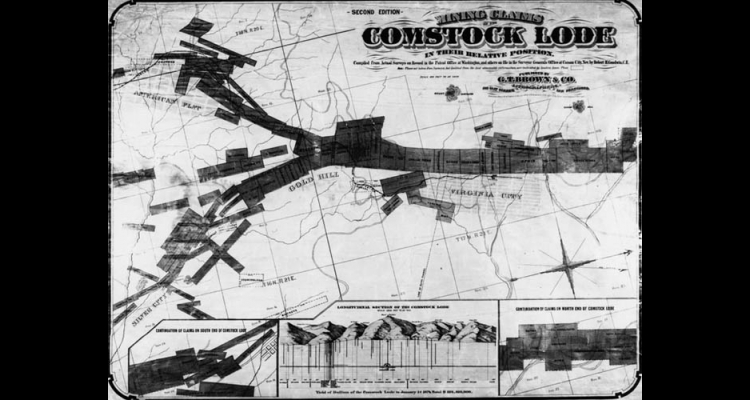Single Ledge Case
One of the most important legal contests in early Nevada history involved two pairs of corporations owning adjacent Comstock mines. The Chollar (pronounced "collar") and Potosi Mines and the Ophir and Burning Moscow had similar situations. In both cases, lawyers argued that either a single ore body was dipping from one mine to the next or there were multiple ore bodies (or ledges), which neighboring mines had a right to develop independently. Lawyers filed the first of several lawsuits in December 1861.
Precedent in mining law, established in the California Gold Country, allowed an original owner to follow the claimed feet of an ore body wherever it led underground. The Chollar at the south end of Virginia City and the Ophir to the north were the older properties. They maintained their younger neighbors were working ore bodies tied to the original claims. The newer Potosi and the Burning Moscow argued the Comstock Lode consisted of many discrete, unlinked ore bodies and they were working distinct, separate pockets of gold and silver.
Prominent Virginia City attorney William Stewart championed what is often called the single ledge position for the Chollar in the more pivotal of the two legal actions, which spanned four years. Individual miners, working on the Comstock as they had in California during the 1850s, opposed the single ledge argument because it would have placed Comstock wealth in the hands of a few. Most favored the idea of many independent ore bodies, believing that would be in the interest of the common man, giving anyone the chance to strike it rich. Initially, the territorial Supreme Court sided with Stewart, but Justice Gordon N. Mott, confronted with his unpopular decision, resigned in 1863. His replacement, John Wesley North, favored the multiple ledge argument, pitting the court against Stewart. During a January 1864 vote on a proposed Nevada constitution, voters correctly concluded that Stewart hoped to use a new state government to elect friendlier judges. The constitution failed to acquire a majority.
While the Supreme Court upheld the multiple ledge theory, an 1864 Comstock depression inspired residents to reassess the single ledge argument. Many now concluded that a decision in favor of the single ledge theory would enhance the district's economic health, assisting large corporations to raise the capital needed to find and exploit ever-deeper deposits. Public opinion shifted and turned against Justice North. In August 1864, he changed his position and ruled in favor of the Chollar, but it was too late to reverse popular opinion, and he resigned his position.
Voters passed a state constitution in September 1864, and a Stewart-friendly court assumed control. Before the new justices could close the case, the Chollar purchased the Potosi operation in 1865. Ultimately, geologists concluded the Comstock was, in fact, one large ore body running along a single fault line. Separate, neighboring mines could exist along the north-south axis of the Lode, but competing claims to the east or west would likely yield to the sole ownership of those who possessed the original feet along the fault.
The finding in favor of the single ledge opened the door for the Bank of California to monopolize the Comstock. A decision in favor of the existence of scattered, discrete ore bodies would have inhibited a single corporation from gaining control of the mining district. Coincidentally, small mines would have faced a challenge to muster the needed capital to search for the depths. The resolution of this case ensured a prosperous future for the Comstock and Nevada.
Article Locations
Related Articles
None at this time.



